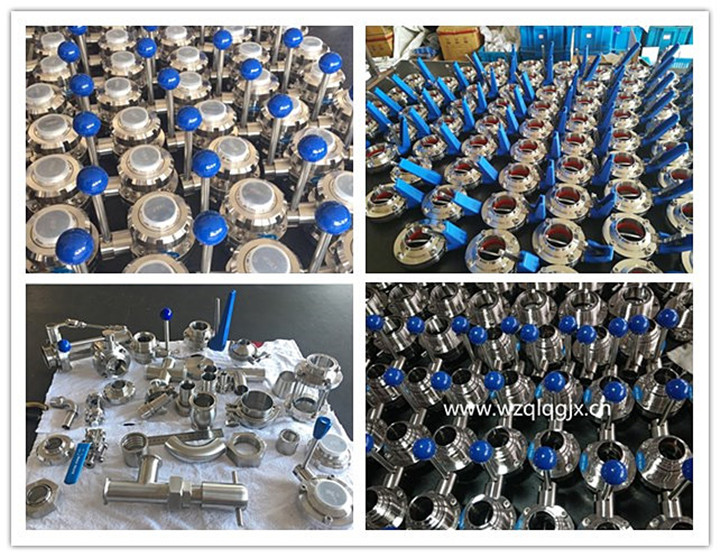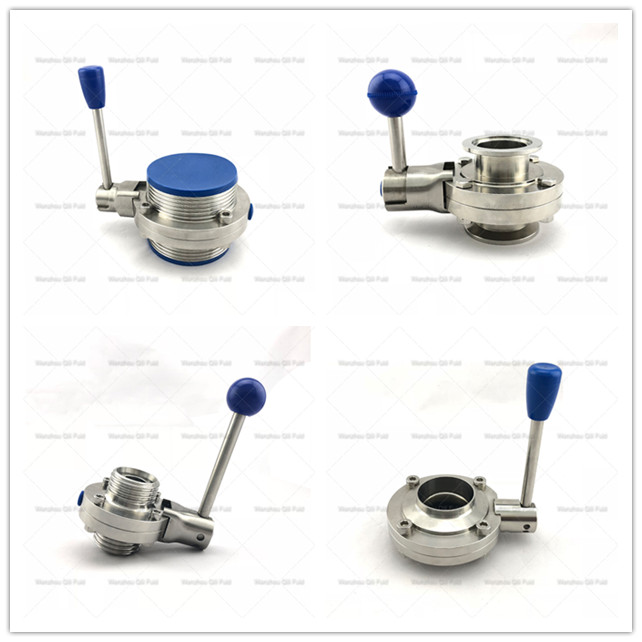
Privacy statement: Your privacy is very important to Us. Our company promises not to disclose your personal information to any external company with out your explicit permission.
Stainless steel sanitary butterfly valve / valve types and uses

If you have any questions ,plz contact Miss Cherry Mobile : 0086-15967457795 Emails : sales13@wzqlqgjx.cn
It's my pleasure to serve you
(1) Truncation categories: such as gate valve, globe valve, plug valve, ball valve, butterfly valve, needle valve, diaphragm valve.
Truncated valve, also known as closed-circuit valve, globe valve, its role is to connect or cut off the medium in the pipeline.
Check valve, also known as one-way valve or check valve, check valve is an automatic valve, its role is to prevent pipeline backflow of media to prevent the pump and drive motor reversal, and container media leakage. Water pump off the bottom valve also belong to the check valve category.
Explosion-proof valve, accident valve, the role of safety valve is to prevent the pipeline or device in the media pressure exceeds the prescribed value, so as to achieve the purpose of security.
Regulating valve, throttle and pressure reducing valve, its role is to adjust the medium pressure, flow and other parameters.
(2) Vacuum categories: such as vacuum ball valve, vacuum flapper valve, vacuum inflation valve, pneumatic vacuum valve and so on. Its role is in the vacuum system, used to change the direction of the air flow, adjust the size of the gas flow, cut off or connected to the pipeline vacuum system components called vacuum valves.
(3) special purpose categories: such as pig valve, vent valve, drain valve, exhaust valve, filter and so on.
Exhaust valve piping system is an essential auxiliary components, widely used in boilers, air conditioners, oil and gas, water supply and drainage pipelines. Often installed in the commanding heights or elbows, etc., to exclude excess gas pipeline, pipelines to improve the efficiency and reduce energy consumption.
Press the main parameters
Press the nominal pressure
(1) Vacuum valve: refers to the working pressure is lower than the standard atmospheric pressure valve.
(2) low-pressure valve: refers to the nominal pressure PN ≤ 1.6Mpa valve.
(3) Medium pressure valve: refers to the nominal pressure of PN 2.5Mpa, 4.0Mpa, 6.4Mpa valve.
(4) high-pressure valve: refers to the nominal pressure PN is 10.0Mpa ~ 80.0Mpa valve.
(5) high pressure valve: refers to the nominal pressure PN ≥ 100.0Mpa valve.
By working temperature
(1) cryogenic valve: for medium temperature t
(2) room temperature valve: for medium temperature -29 ℃
(3) in the temperature valve: for medium temperature 120 ℃
(4) high temperature valve: for the medium temperature t> 425 ℃ valve.
Press drive mode
Classified by the drive mode is divided into automatic valves, power-driven valves and manual valves
Compressed air driven valve. Hydraulic valve: With the help of oil and other liquid pressure-driven valve.
In addition there are several combinations of the above driving methods, such as gas - electric valve.
By nominal diameter
(1) small diameter valve: nominal diameter DN ≤ 40mm valve.
(2) in the diameter of the valve: Nominal diameter DN 50 ~ 300mm valve.
(3) large diameter valve: Nominal valve DN is 350 ~ 1200mm valve.
(4) Extra large diameter valve: nominal diameter DN ≥ 1400mm valve
By structural features
Valve structural features Valve structural features The structural features of the valve is based on the closure member relative to the direction of movement of the valve seat can be divided into:
(1) cut-off form: the closure moves along the center of the valve seat; such as the valve
(2) cock and spherical: the closure is a plunger or ball, rotating around its own center line; such as plug valves, ball valves
(3) Gates: Closure moves along the vertical seat center; such as gate valve, gate and so on
(4) Turn-on: closed pieces around the seat outside the axis of rotation; such as swing-type check valve
(5) butterfly: the closure of the disc, rotating around the seat within the shaft; such as butterfly valve, butterfly check valve, etc.
(6) Sliding valve: The closing piece slides in a direction perpendicular to the passage. Such as slippery
Press the connection method
(1) Threaded valve: the body with internal or external thread, threaded pipe.
(2) flange connection valve: body with a flange, pipe flange connection.
(3) welding connection valve: body with a welding groove, and pipe welding connection.
(4) clamp connection valve: body with a clip, and the pipe clamp connection.
(5) ferrule connection valve: pipe and pipe connection.
(6) on the folder connected to the valve: Bolt directly to the valve and the two ends of the pipe through the folder with the connection form.
Press body material
(1) metal valve material: the body and other parts made of metal materials. Such as cast iron valves, cast steel valves, alloy steel valves, copper alloy valves, aluminum valves, lead alloy valves, titanium valves, Monel valves.
(2) non-metallic materials Valve: the valve body and other parts made of non-metallic materials. Such as plastic valves, enamel valves, ceramic valves, glass steel valves.
The following is several stainless steel valve material parameters and the specific use
(1) Angle travel includes ball valves, butterfly valves, plug valves and other categories
(2) Straight travel including gate valve, globe valve, corner seat valve and so on.
This classification method not only by principle, role and structure by the division, is currently the most common international and domestic classification methods. General sub-gate valves, globe valves, throttle valves, instrumentation valves, plunger valves, diaphragm valves, plug valves, ball valves, butterfly valves, check valves, pressure relief valve safety valve, Sewage valve and so on.
As the valve is used for a wide range of purposes, it plays a large role. For example, valves can control the operation of boilers and steam turbines in power plants. In petroleum and chemical production, valves also function to control all production equipment and processes. In other departments as well. However, valves are often overlooked compared to other products. For example: When installing machinery and equipment, people often focus on the main machinery and equipment, but ignore the valve. This will reduce the overall production efficiency or stop production, or cause a variety of other accidents. Therefore, the valve selection, installation, use, etc. must be serious and responsible work.
Electric drive valve is commonly used drive-type valve, usually referred to as drive device in the form of valve actuator, valve electric device features are as follows: 1) quickly open and close, you can greatly shorten the time required to open and close the valve; 2) can greatly reduce the labor intensity of the operator, especially for high pressure, large diameter valves; 3) is suitable for installation in the position can not be manually operated or difficult to reach, easy to achieve long-distance operation, and the installation height is unlimited; 4 ) Facilitates the automation of the entire system; 5) The power source is more readily available than the gas and liquid sources and the laying and maintenance of the wires is much simpler than that of compressed air and hydraulic lines.
The disadvantage of valve electric devices is the complex structure, more difficult to use in wet places, when used in explosive media, the need to use explosion-proof measures.
Valve actuators driven by the valve type is different, can be divided into two types of Z and Q type. Z-type valve electric device output shaft can turn out a lot of laps, suitable for driving gate valve, globe valve, diaphragm valve, etc .; Q-type valve electric device output shaft can only rotate 90 °, suitable for driving plug, ball valve and butterfly valve . According to the type of protection are ordinary type, flameproof type (B), heat-resistant type (R) and triple type (that is, outdoor, anti-corrosion, flameproof,
Valve electric devices generally by the transmission (gear), motor, travel control agencies, torque limit agencies, manual - electric switching mechanism, opening indicator and other components.
Pneumatic and hydraulic valves
Pneumatic valves and hydraulic is a certain pressure of air, water or oil as the power source, the use of cylinder (or hydraulic cylinder) and the piston movement to drive the valve, the general pneumatic pressure of air is less than 0.8MPa, hydraulic pressure or Hydraulic pressure is 2.5MPa ~ 25MPa. Such as for driving diaphragm valve; rotary gas, liquid drive device used to drive ball valves, butterfly valves or plug valves. The driving force of hydraulic device is large, suitable for driving large-caliber valves. Such as used to drive the plug valve, ball valve and butterfly valve, the piston must reciprocate motion conversion surface rotation. In addition to using the cylinder or cylinder piston to drive, there are driven by the pneumatic film, because of its smaller stroke and driving force, it is mainly used for regulating valve.
Manual valve
Manual valve is the most basic way of driving the valve. It consists of direct drive by handwheel, handle or wrench and drive by drive mechanism. When the valve opening torque is large, can be driven by gear or worm gear to achieve the purpose of omission. Gears drive split spur gear drive and bevel gear drive. Gear reduction ratio is small, suitable for gate valve and globe valve, worm gear drive slowdown, suitable for plug flash, ball valve and butterfly valve.

Author:
Ms. Amber
Phone/WhatsApp:
Mail an Lieferanten
Author:
Ms. Amber
Phone/WhatsApp:
June 27, 2018

Privacy statement: Your privacy is very important to Us. Our company promises not to disclose your personal information to any external company with out your explicit permission.

Fill in more information so that we can get in touch with you faster
Privacy statement: Your privacy is very important to Us. Our company promises not to disclose your personal information to any external company with out your explicit permission.